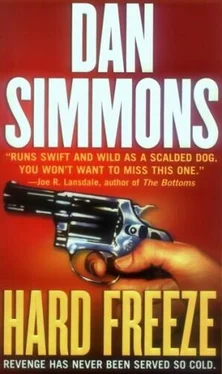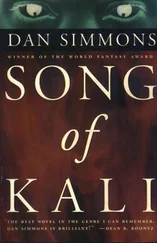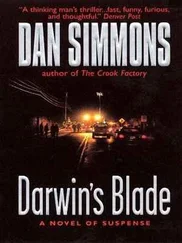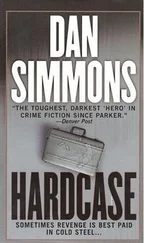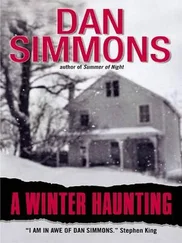"Now that is truly weird," Kurtz said aloud. "Him joining the army. And demolitions, no less."
"I thought that violinists wouldn't even play catch, they were so protective of their hands," said Arlene.
"What's this thick stack of medical stuff?"
"Mr. Frears is dying of cancer," said Arlene, stubbing out her cigarette and lighting another. "Colon cancer."
Kurtz was looking at the information from Sloan-Kettering Hospital.
"He's undergone every form of treatment, chemotherapy literally up the wazoo," continued Arlene, "but it's terminal. But look at the concert schedule he's been keeping during all of this."
Kurtz flipped to a separate printout. "Two hundred and ten days a year on the road," he said. "And except for the last couple of weeks, he's honored almost all of them."
"Tough guy," said Arlene.
Kurtz nodded and opened the James B. Hansen file.
"Dead guy there," said Arlene.
"So they say."
"A long time ago," said Arlene.
Kurtz nodded, reading the police report of young Crystal Frears's murder and the subsequent murder-suicide of Hansen and his family. The details matched what John Wellington Frears had told him.
"I couldn't help but notice the connection there," said Arlene. "Does Mr. Frears think that this Hansen is still alive?"
Kurtz looked up. Even when he was a practicing P.I., he'd shared only the necessary details of cases with Arlene, not seeing a need to dump such facts on her. But her husband and son had been alive then, and she'd probably had more important things on her mind. "Yeah," said Kurtz, "that's exactly what Frears thinks. He was leaving Buffalo a couple of weeks ago…"
"I saw the concert booking on his itinerary," said Arlene, motioning with her coffee cup for Kurtz to go on.
"He thought he saw Hansen at the airport."
"Our airport?"
"Yeah."
"Do you think he did, Joe? See Hansen, I mean."
Kurtz shrugged.
"Where is Mr. Frears now?"
"Still out at the Airport Sheraton. Waiting."
"For what?"
"I'm not sure," said Kurtz. "It sounds like Buffalo Homicide isn't looking into anything for him. Maybe Frears can't leave town while there's a chance he could find Hansen here, but he's too sick to look."
"So he's waiting here to die at the Airport Sheraton."
"I think it's more than that," said Kurtz. "Mr. Frears has made a big stink with the police, got a little sidebar in the Buffalo News about seeing his daughter's murderer at the airport, even got an interview on a local talk-radio station. And he always mentions that he's staying at the Sheraton."
"He wants Hansen—if Hansen exists—to find him," Arlene said softly. "He wants Hansen to come out of hiding to kill him. Make the police take it all seriously."
Kurtz closed the Hansen file and picked up the "Other Murder-Suicides/Common Factors" folder. In the last twenty years there had been 5,638 murders of children and wives followed by the suicide of the male killer. There had been 1,220 male suicides before the police could arrest the suspect after child molestation and/or murder of a female child or teenager.
"Oy," said Kurtz.
"Yeah," agreed Arlene. She had finished her coffee break, lit another cigarette, and was working at her computer again. Now she lifted another, thinner, folder and carried it over to Kurtz's desk. "So I narrowed the parameters to include just perps who raped and murdered a teenage girl about Crystal Frears's age and who then went home and killed either themselves or their own family, after burning the house down around themselves."
"There can't be too many of those," said Kurtz. There were 235 cases resembling that scenario, but only thirty-one of them involved men about the age of James B. Hansen at that time. It took only a minute for Kurtz to go through the photographs and compare them to the photo in the Hansen file from the Chicago P.D.
"Bingo," said Kurtz. Atlanta, Georgia, five years after the murder of Crystal Frears. A white man who looked very little like psychologist James B. Hansen—bald rather than long-haired, clean-shaven rather than bearded, brown eyes rather than blue, thick glasses where Hansen had worn none—but who was the same man. Lawrence Greenberg, age thirty-five, a certified public accountant, married three years, three children by his wife's former marriage, had kidnapped a neighbor girl, white, age thirteen, named Charlotte Hays, raped her repeatedly in a deserted farmhouse outside of Atlanta, and had then driven home, had dinner with his family, shot all four of them, and reportedly shot himself in the head after setting fire to his home. Police had identified him according to dental records and a charred Rolex that Mr. Greenberg had always worn.
"Dental records," said Kurtz.
"Yeah, but to look at those details, we'll need the printouts of the full reports," said Arlene. "The Chicago P.D. file hadn't been fully digitized—just the overview you have there—so we'd have to make an official request."
"Erie County District Attorney's Office at our third P.O. box," said Kurtz.
"Mail fraud as well as everything else," said Arlene. "At least three federal laws broken if we do it."
"Do it," said Kurtz.
"I called yesterday," said Arlene. "Requested the files from both Chicago and Atlanta. I had them Express Mailed since FedEx won't deliver to P.O. boxes. We'll get the reports on Monday."
"How did you pay?"
"Charged it to the D.A.'s office," said Arlene. "I still have their billing code."
"Won't they notice it?"
Arlene laughed and went back to her computer. "We could charge a fleet of Lexuses to that office, Joe. No one would notice. Do you have time to look at some possible office space with me today?"
"No, I've got things to do. But I do need your help on something."
Kurtz drove alone to the bar near Broadway Market, where he'd braced Donnie Rafferty. Detectives Brubaker and Myers had been driving a different unmarked car that morning when they had followed him from the Royal Delaware Arms to his office, and they had stayed several cars back and attempted a serious tail rather than just harassing him, but Kurtz had made them immediately. If they stopped him now with the two guns he was carrying, it would be bad news, but he suspected that they were actually on surveillance. He pulled into the parking lot, grabbed the camera bag he'd brought from the office, and went into the bar. He noticed that Brubaker and Myers parked across the street to watch the parking lot and the bar's only entrance. When he'd been waiting for Donald Rafferty here, Kurtz had noticed the alley running behind the row of buildings and the high board fence concealing the alley from the parking lot.
"Back door?" Kurtz said to the bartender in the dark, hops-smelling space within. Only three or four committed regulars were celebrating Saturday morning there.
"It's for emergency use only," said the bartender. "Hey!"
Kurtz stepped into the alley, Arlene guided her blue Buick to a stop, and he got in. They drove a block, turned north, then turned west on a street parallel to where the detectives were parked.
"Where to?" asked Arlene.
"Back to the office for you," said Kurtz. "I have to borrow your car for a few hours."
Arlene sighed. "We're not that far from Chippewa Street. We could check out an office space there."
"I bet it's over a Starbucks," said Kurtz.
"How did you know?"
"Every third store on Chippewa is a Starbucks these days," said Kurtz. "I don't have time today. And we don't want to pay yuppie leases. Let's find an office somewhere less gentrified."
Arlene sighed again. "It would be nice to have windows."
Kurtz said nothing on the ride back to the office.
The Tuscarora Indian Reservation was northeast of the city of Niagara Falls, curled around half of the big Power Reservoir that stored water to run through the Power Project's giant turbines. Big Bore Redhawk was not a Tuscarora, and quite possibly wasn't an Indian—word was that Big Bore had discovered his Native American ancestry when he was trying to fence stolen jewelry and learned that he would be tax-exempt as an Indian jewelry salesperson—but his trailer was on the reservation property. Kurtz knew so much about Redhawk's personal life because the big man had been one of the most talkative morons in C-Block.
Читать дальше
